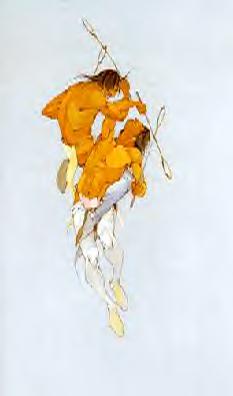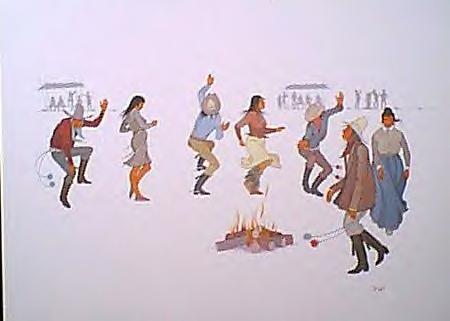|
Note: Cultural information may vary from clan to clan, location to location, family to family,
and from differing opinions and experiences. Information provided here are not 'etched in stone'.
Traditional Religious Beliefs of the Cherokee
 A-ne-jo-di,
or Stickball, is a very rough game played by not only the Cherokee, but many other Southeastern Woodland tribes
including the Muscogee (Creek), Seminole, and others. A-ne-jo-di,
or Stickball, is a very rough game played by not only the Cherokee, but many other Southeastern Woodland tribes
including the Muscogee (Creek), Seminole, and others.
The game resembles the modern European game of LaCrosse, using ball sticks which are
handmade from hickory. A small ball, made of deer hair and hide, is tossed into the air by the medicine man. The
male players use a pair of the sticks, and female players use the bare hands. In earlier times, only the men with
the greatest athletic ability played the game. The game was oftentimes played to settle disputes, and the conjurer
for each team often became as important to the team as the players themselves.
Seven points are scored when the ball strikes a wooden fish on the top of a pole approximately
25 feet in height, and two points are awarded when the ball strikes the pole.
In earlier days, there would be a dance before the ballgame. The ballplayers were the
participants of the dance, along with seven women dancers. Each woman represented one of the clans. Throughout
the dance, the women would step on black beads which represented the players of the opposing team. The conjurer
had placed these black beads on a large flat rock.
Today, stickball is an important part of the days activities at ceremonial Stomp Grounds,
being necessary to play before the Stomp Dance can ever begin. It is also a recreational sport at other times between
community teams. There are also intertribal teams made up of players from Cherokee, Muscogee (Creek), Yuchi, Natchez,
and other area communities.
Stomp Dance
The traditional religious dance of the Cherokee is the Stomp Dance at a sacred dance
site. The sacred fire is kept burning constantly which is built by the fire keeper and his assistant. A firekeeper
and the assistant begin early in the day at dawn, stoking the burning embers into a large fire for the dance.
Seven arbors are located around the fire and dance area. They are made from large poles with brush for the roofs.
Each arbor is reserved for one of the seven clans. Seats are placed between the arbors for visitors. The dance
ceremony cannot begin unless each clan is represented.
Women prepare a meal for the day, which consists of traditional and modern food such as brown beans, cornbread,
all kinds of pies, cakes, homemade biscuits, salad, ice tea, coffee, kool aid, chicken, and if in season, kanuchi,
wild onions with eggs, bean bread and much more.
A-ne-jo-di (Stickball) is played in the afternoon.
At sundown, the sermons continue. The Chief brings out the traditional pipe, and fills it with tobacco. He lights
it with a coal from the Sacred Fire, and takes seven puffs. The Medicine Man from each clan, beginning with the
Aniwaya, the Wolf clan, takes seven puffs from the pipe and passes it on . The chief, medicine men and elders hold
a meeting and then issue the call for the first dance, then the second call.
The first dance is by invitation, tribal elders, elders, medicine men and clan heads.
 The members gather to visit
and dance until sunrise. Each individual ground has itís own schedule
for the dances, which is a holy place to worship God. All grounds post
signs requesting no rowdiness, liquor, and general respect. Two major
ceremonies are held at the Redbird Smith Ground, one commemorating the
birth of Redbird Smith, and the other expresses appreciation to the
Creator for a bountiful harvest. The members gather to visit
and dance until sunrise. Each individual ground has itís own schedule
for the dances, which is a holy place to worship God. All grounds post
signs requesting no rowdiness, liquor, and general respect. Two major
ceremonies are held at the Redbird Smith Ground, one commemorating the
birth of Redbird Smith, and the other expresses appreciation to the
Creator for a bountiful harvest.
Stomp Dance participants include a leader, assistants, and one or more female shell shakers who wear leg rattles
traditionally made out of turtle shells filled with pebbles. Some wear shakers made from small milk cans. The shakers
provide rhythmic accompaniment while dancing around the fire, and a dance cannot begin without the shakers.
A series of wampum belts serve to record and Ďreadí the traditional beliefs and stories. The belts are very old,
and are made of wampum beads sewn together with a form of seaweed from old Mexico. The wampum belts are shown only
on very sacred occassions. The history of the belts relate that many years ago, the tribe was preparing to go to
war. The medicine men foresaw which would survive, and cut the original wampum belt into seven pieces. After the
war, the belts were scattered, and the last one was recovered by Redbird Smith in the very early 1900ís.
The fire is very sacred to traditional Cherokees. It is built at the bottom of a pit below the ground, and burns
constantly. It is believed by traditional Cherokees that soon after creation of the Cherokee people, the Creator
left his throne in Heaven and visited the earth. He chose four Cherokee men who were strong, healthy, good and
true, and believed with all of their heart in the Creator. They were each given a name: Red, Blue, Black and Yellow.
Each was given a wooden stick that was very straight, and
was told to place one end of the stick on a surface that would not burn. He said to place the other end in their
hands, and start this material that would not burn to magically burn. . . by giving the sticks a circular, rotating
motion. When this was done, and all the sticks were burning, they were told to go to the center of the cross, and
there the four would start one singular fire. This fire would burn for all time, and be the Sacred Fire. The fire
was started with the instructions and help of the Creator.
The Sacred Fire has been held since that time by the Cherokee, and is kept alive by the Chief, Assistant Chief,
Firekeeper, and Assistant Firekeepers of the Ground.
Today, there are over 200,000 Cherokee tribal members. Although some have chosen to worship through other religious
denominations (Indian Baptist, Methodist, etc.), many continue to worship at
regular Stomp Dances and are members of one of the several Grounds in Cherokee Nation. Each ground has its own
unique protocol and differences, but the general worship is similar with the same intention.
To follow-up on this story...read "The Ball Game Between the Birds
and the Animals"
Info provided by the Cherokee Nation Cultural Resource Center
cultural@cherokee.org
|